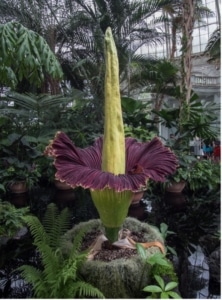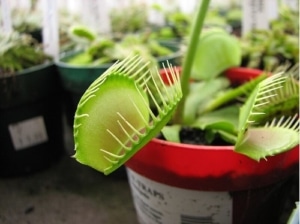DCPA NEWS CENTER
Enjoy the best stories and perspectives from the theatre world today.
Enjoy the best stories and perspectives from the theatre world today.
I will be frank: the Denver Center Theatre Company production of Little Shop of Horrors has shaken my gardening confidence. If the story of Mushnik’s Flower Shop taught me one thing, it’s that plant care is a life-threatening and morally fraught enterprise. So, with spring and a sense of doom in the air, I made a visit to the tropical greenhouses at Denver Botanic Gardens, where horticulturalist Nicholas Giaquinto helped me separate floral fact from fiction. Our following conversation has been condensed and lightly edited for clarity.
When you’re caring for carnivorous plants, to what degree are you fearing for life and limb?

The noncarnivorous Amorphophallis Titanum, or Corpse Flower
None. These are carnivorous plants that are adapted to eat insects. A lot of them grow in boggy areas that are nutrient poor, so the primary way that they supplement their diet is to have adaptations to eat insects. None of them are harmful to people.
So, to the best of your knowledge, no person—
No person has ever been eaten to my knowledge.
But I understand there’s a flower here called the corpse flower. Based on the name, I assume that plant has killed multiple people.
No, the corpse flower is named that because it has a putrid smell—some people say like rotting flesh.
So, despite the name, the corpse flower is not a carnivorous plant?
It is not.
What are some of the carnivorous plants in the collection here?

Venus Flytrap
There are some butterwort, [there are] sundew. The Venus flytrap’s a pretty common one that a lot of people know. And then there’re two pitcher plant types: one is Sarracenia, which is grown in North America, and then Nepenthes, which are more tropical, so you’ll find them in tropical Asia, Australia, et cetera. Their trapping mechanism is obviously this pitcher, and then they have an enzyme inside the leaf itself that digests whatever falls into there. (Nick tips the Nepenthes pitcher upside down; a clear liquid spills onto the ground.)
So, if that had landed on my foot, would my foot be dissolved?
No. This stuff has fallen on me all the time. It’s just gross.
In terms of prey, is it insects across the board or is there some variation?
They are targeting insects primarily; the Nepenthes, some of them can be large enough where small animals can fall in and be digested in the pitcher of the plant itself. But a lot of the mechanisms that are trapping these insects are usually small, so it has to be like the size of a small insect to be trapped in a lot of these.

Nepenthes pitcher plant
If I’ve got a fruit fly or an ant problem in my home, is acquiring some of these plants a valid strategy to address that?
No, I would acquire poison and just poison them. For insects in general, it’s not a great way to control a population if you’re having an ant issue in your house. With these carnivorous plants, they will attract insects that you probably didn’t know that you had in your house.
It’s not like you should be like, “I’m gonna buy a bunch of butterworts and set them around.” No, just buy ant bait.
In Little Shop of Horrors, the show’s protagonist, Seymour, acquires a plant that’s doing very poorly. Eventually he discovers that the only way to nourish this plant is via human blood. In your professional opinion, what would happen if I attempted to water my own houseplants with human blood?
You would kill it. Plants need water; they’ve been adapted for that. Blood has so many other things in it that you would just kill the plant. Just be normal and stick with water.
Little Shop is a musical, and I’ve heard conflicting things about plants and their responses to music, whether music is good for their growth. What’s the ground truth on that?

Sundew
There have been some studies that plants respond well to music, which could just be from the sound vibrations. Or, I guess if people are singing, it would be like you’re producing more carbon monoxide toward the plant if you’re singing to the plant itself. So, there has been some research that has said that music is positively affecting your plant.
Do you play any music here?
I play music, but not for the plants. I play it for my own sanity. Usually when I’m repotting plants.
Do you have a specific repotting playlist?
No, it depends on the mood that day. It can range.
When you’re working with different plants, do you find yourself projecting personalities onto them?
I try to not anthropomorphize everything in my life. I don’t try to graft personalities onto my plants. I try to be normal.
In Little Shop, Seymour is in love with a woman named Audrey, so he gives his plant the name Audrey II. Do you ever name the plants you work with?
So, when our Amorphophallus titanum [corpse flower] bloomed, the first one that bloomed is called Stinky. I was not here when that one bloomed. I started like a month later. The second one I was able to get to bloom, so [that was] another Amorphophallus that we wanted to have a name. I was pushing really hard for Joe Pesci as the name, just ’cause I want to meet Joe Pesci. He’s obviously an icon that we all want to meet. But it wasn’t allowed, and instead it was called Little Stinker. Lame name, I’m sorry, but…yeah. So anytime someone asks me its name: its Christian name is Joe Pesci, but it’s Little Stinker to the public.
Given that I’m here on behalf of an arts institution, if I can ever pull any levers to get you to meet Joe Pesci, I will do so.
I would love it. Thank you so much.
